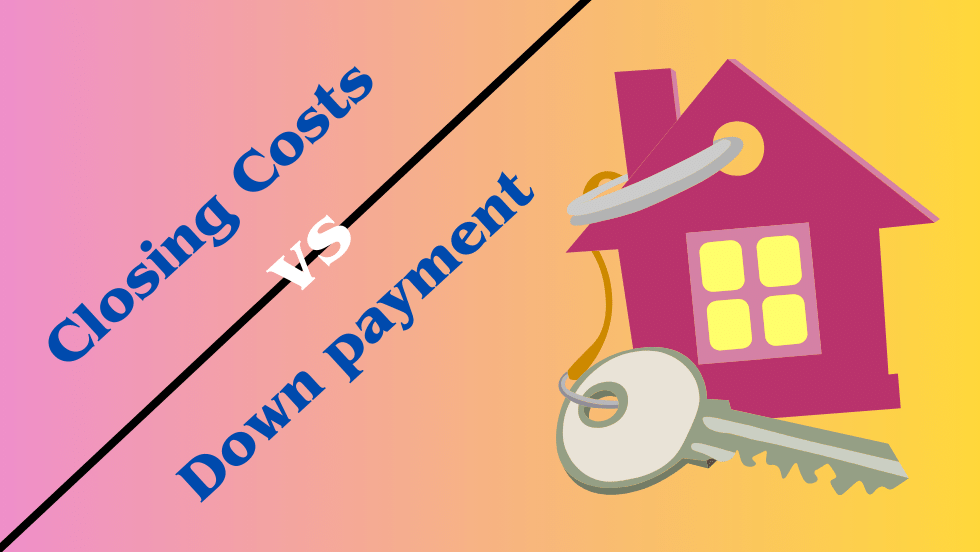Buying a home is one of the biggest investments that most people will make in their lifetime. It’s an exciting process but can also be overwhelming with all the financial aspects involved. Two key terms you’ll hear when purchasing a house are closing costs and down payments.
But what exactly are closing costs and down payments, and how do they differ? Understanding the difference between closing costs and down payment is essential when navigating the realm of real estate.
What is a closing cost?
A closing cost is a fee paid by the buyer and seller at the end of a real estate transaction. It is typically calculated as a percentage of the total purchase price and covers various services and expenditures associated with transferring property ownership.
Some common examples of closing costs include:
Mortgage application fee: This is a cost the lender charges for processing your mortgage application.
Home inspection fee: Before finalizing the purchase of a property, buyers often hire a professional home inspector to assess the situation of the property and identify any potential issues. The inspector’s services come at a cost typically paid at closing.
Title search and insurance fees:A title examination is a process of examining public records to verify property ownership. Title insurance saves the buyer or lender from legal claims against the property. Both these fees are usually incurred by the buyer at closing.
Appraisal fee: Lenders need an appraisal to check the fair market value of a property before approving a mortgage loan. The buyer generally pays the cost of this appraisal.
Attorney fees: In some cases, buyers and sellers may use an attorney to represent their interests in a real estate transaction. These legal fees are usually paid at closing.
What is a down payment?
A down payment is a lump sum of money paid upfront towards the buy price of a property. It is typically expressed as a percentage of the total purchase price, with most lenders requiring a minimum down payment of around 20%.
The purpose of a down payment is to reduce the amount of money needed for a mortgage loan and mitigate the lender’s risk. By putting in a significant amount of money upfront, the buyerhas more equity in the property and is less likely to default on their loan.
In addition to reducing the risk for lenders,a larger down payment can lead to more suitable mortgage terms and lower interest rates. It also means having a smaller loan amount and potentially paying off the mortgage sooner.
Some common examples of down payment include:
Cash: Buyers can use their savings or funds from investments to make a down payment.
Gift money: Some buyers may receive financial assistance from family members or other sources towards their down payment.
Retirement accounts: In some cases, buyers can borrow against their retirement accounts, such as 401(k) plans, for a down payment. However, this option should be carefully considered as it can result in penalties and taxes.
Government assistance programs: Depending on their income and location, buyers may qualify for down payment assistance from state or local government agencies.
What is the difference between closing cost vs down payment?
You’re not alone if you think down payment and closing costs are the same. Many people use these terms interchangeably, but they refer to two distinct aspects of the home-buying process.
Closing costs refer to the expenses and fees associated with finalizing a real estate transaction, like obtaining a mortgage, transferring ownership of the property, and paying for any necessary services or inspections. These costs include appraisal fees, title search fees, attorney fees, and transfer taxes.
Down payment refers to the initial payment that is made towards the purchase of a home. It is typically expressed as a percentage of the total purchase cost and is paid at closing, along with any other closing costs.
The lender determines closing costs, which can vary depending on parameters such as location, loan type, and the down payment size. The amount can range from 2% to 5% of the home’s total purchase price.
On the other hand, down payment amounts are typically determined by the lender and can vary based on characteristics such as credit score, loan type, and financial history. Generally, a higher down payment indicates a lower monthly mortgage payment and less interest over time.
While closing costs are non-negotiable, there may be room for negotiation regarding the down payment. Some lenders may offer different options for down payments, such as a lower percentage with a higher interest rate or a higher percentage with a lower interest rate.
Closing and down payments are necessary when purchasing a home, but they serve different purposes. Closing costs cover the fees associated with finalizing the transaction, while the down payment is a portion of the overall purchase price paid upfront.
How Closing Cost is Calculated
Closing costs are typically calculated as a percentage of the property’s total purchase price and can range from 2% to 5%. The exact amount can vary depending on location, loan type, and lender fees.
To estimate your closing costs, getting a loan estimate from your lender is recommended. This will break down the potential fees and expenses associated with your specific loan and give you a more accurate estimate of what to expect at closing.
Example 1. Property in a high-cost area with a conventional loan:
Loan amount: $400,000
Closing costs: 3% of purchase price ($12,000)
Example 2. Property in a low-cost area with an FHA loan:
Loan amount: $200,000
Closing costs: 5% of purchase price ($10,000)
How Down Payment is Calculated?
The down payment is a lump sum payment made towards the property’s purchase price. It is typically calculated as a percentage of the total purchase price, ranging from 3% to 20%. The amount required for a down payment can also vary depending on factors such as credit score, loan type, and lender requirements.
To determine your down payment, you will need to consider the property’s purchase price and how much you can afford to put towards it.
Example 1- Property with a purchase price of $250,000 and a required down payment of 5%:
Down payment: $12,500
Example 2- Property with a purchase price of $500,000 and a required down payment of 20%:
Down payment: $100,000
It is important to note that the down payment is not the only upfront cost of purchasing a property. As mentioned before, closing costs also need to be taken into consideration.
Frequently Asked Questions
Q: Can the down payment be financed into the loan?
A: It is rare for lenders to allow financing of the down payment into the loan, but some may offer this option. However, remember that this will increase your overall loan amount and potentially result in higher monthly payments.
Q: Are there any assistance programs available for down payments?
A: Yes, there are various programs and grants available that can help with down payment assistance. These options may have specific eligibility requirements, so it is important to research and speak with your lender for more information.
Q: Is a larger down payment always better?
A: A larger down payment can result in lower monthly payments and potentially eliminate the need for private mortgage insurance (PMI).
Are closing costs and down payment the same thing?
No, closing costs and down payment are not the same thing. While both involve upfront payments towards purchasing a property, closing costs include additional fees and expenses such as appraisal, title insurance, and escrow fees. The down payment is specifically for the purchase price of the property. It is important to budget for both when planning to buy a home.
Conclusion
In summary, you get answers about whether closing costs are separate from the down payment, down payment calculation, and how closing costs are calculated. It is important to budget for the down payment and closing costs when purchasing a property.
Both closing costs and down payment play important roles in home buying. Understanding how they are calculated and factor them into your budget when purchasing a property is crucial. Consulting with your lender and researching available assistance programs can also help alleviate some of the financial burden of these upfront costs.
References:
- “Closing Costs.” Investopedia, 17 June 2021, www.investopedia.com/terms/c/closing-costs.asp.
- “Down Payment.” Consumer Financial Protection Bureau, 21 Sept. 2020, www.consumerfinance.gov/ask-cfpb/what-is-a-down-payment-en-1952/.
- “How to Calculate Closing Costs.” Realtor.com, 24 June 2021, www.realtor.com/advice/finance/how-to-calculate-closing-costs/.
- “How to Calculate Your Down Payment.” Bankrate, 18 Feb. 2021, www.bankrate.com/mortgages/down-payment-calculator/.

Corey has over 15 years of experience as a real estate broker and educator. He is dedicated to providing valuable insights and guidance for those looking to enter the real estate industry.

